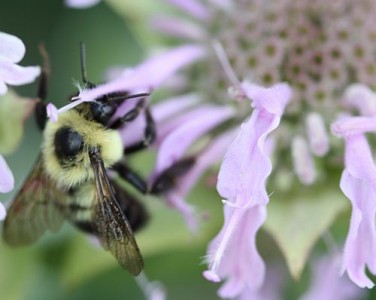From: http://www.xerces.org/native-bees/
 Bumblebees are the only bees native to the US that are truly social. They live in colonies, share the work, and have multiple, overlapping generations throughout the spring, summer, and fall. However, unlike the non-native, European honeybees, the bumble bee colony is seasonal. At the end of the summer only the fertilized queens survive to hibernate through the winter. In the spring, she will found a new nest that eventually may grow to include dozens of individuals (occasionally a couple of hundred).
Bumblebees are the only bees native to the US that are truly social. They live in colonies, share the work, and have multiple, overlapping generations throughout the spring, summer, and fall. However, unlike the non-native, European honeybees, the bumble bee colony is seasonal. At the end of the summer only the fertilized queens survive to hibernate through the winter. In the spring, she will found a new nest that eventually may grow to include dozens of individuals (occasionally a couple of hundred).
Bumblebees need a cavity in which to nest. The queens are opportunists, looking for any suitably sized cavity. Sometimes this is above ground, such as in hollow trees or walls, or under a tussock of grass, but they mostly nest underground. An abandoned rodent hole is a favorite, as this space is warm and already lined with fur. The queen creates the first few brood cells from wax, and then provisions them with pollen and nectar and lays eggs. It will take about a month for her to raise the first brood. When they emerge, these bees become workers, taking on the tasks of foraging and helping the queen tend the growing number of brood cells. The workers may live for a couple of months, by which time there will be more bumblebees to replace them. The queen will continue to lay eggs, so the colony will grow steadily through the summer. At the end of summer, new queens and drones will emerge and mate. As the cooler weather of fall arrives most of the bees, including the old queen, will die, leaving only the new, mated queens to overwinter.
They are generalist feeders, often the first bees active in late winter (February) and the last in fall (November). Since they are active for so many months, they must be able to forage on a wide range of plant species in a wide range of weather conditions to support a colony. Some individual bees in the colony, however, choose to forage exclusively on a single species or a limited range of related plant species, effectively becoming specialist foragers. When foraging, the female bumble bee carries pollen in a concave, hairless area surrounded by stiff hairs on her rear legs, known as the pollen basket or corbicula. This basket can be seen clearly when it is empty and, when full, the pollen ball pressed into it is obvious.
Bumblebees also differ from solitary bees when feeding their larvae. They provide food gradually, adding it to the brood cells as the larvae need it (” progressive provisioning”) rather than leaving all the food in the cell before laying the egg. In addition, bumblebees do make a small amount of honey, just enough to feed the larvae and themselves for a couple of days during bad weather.
Mission of the Xerces Society
The Xerces Society is a nonprofit organization that protects wildlife through the conservation of invertebrates and their habitat. Established in 1971, the Society is at the forefront of invertebrate protection worldwide, harnessing the knowledge of scientists and the enthusiasm of citizens to implement conservation programs. Butterflies, dragonflies, beetles, worms, starfish, mussels, and crabs are but a few of the millions of invertebrates at the heart of a healthy environment. Invertebrates build the stunning coral reefs of our oceans; they are essential to the reproduction of most flowering plants, including many fruits, vegetables, and nuts; and they are food for birds, fish, and other animals. Yet invertebrate populations are often imperiled by human activities and rarely accounted for in mainstream conservation.
The Society uses advocacy, education, and applied research to defend invertebrates.
Over the past three decades, we have protected endangered species and their habitats, produced ground-breaking publications on insect conservation, trained thousands of farmers and land managers to protect and manage habitat, and raised awareness about the invertebrates of forests, prairies, deserts, and oceans.

